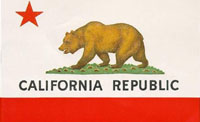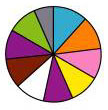Improving the California Republic
by Dave Robinson, CfER member
|
Bold letters on our state flag proclaim us the "California Republic".
What's so great about a republic that we would define our society this way?
|  |
In a republic, according to Thomas Jefferson, "every member composing it has his equal voice in the direction of its concerns ... by representatives chosen by himself and responsible to him at short periods."
It's a brilliant idea, worthy as the foundation of our civilization, and worth defending. But is California truly a republic?
-
In the 2002 election, our governor, lieutenant governor, secretary of
state, controller, treasurer, and insurance commissioner were put into
power with the support of only a minority of voters.
-
The California assembly, our US House delegation, half of our state senate, and the tax-collecting Board of Equalization were all elected with the support of only 19 to 23 percent of eligible voters.
-
Representatives with the support of 8.5 percent of eligible voters (24
percent of participating voters) have the power to pass laws in the state
assembly. Numbers for both the Assembly and Senate were about the same
after the 2004 election. More recent elections have had some stronger mandates, but these results are not far from typical.
Statistics can't capture the depressing feeling of acquiescence that we get when we vote - something that should be an empowering experience. And we will never know what the benefits would have been if each Californian had representatives in Sacramento and Washington whom they supported, and helped elect. Perhaps there would have been no electricity crisis, for example.
What went wrong?
Jefferson and his colleagues understood what a republic should be, but they didn't know how to achieve it. The problem wasn't thought through carefully until several decades after the drafting of the Constitution. Instead, they mostly left it to states to figure it out, and the states adopted the creaky electoral machinery of the nation they had just rebelled from. Then the political battles began, and politicians learned how to work the machinery to their advantage - in fact, only those who did so could gain power. So it became hard to change.
The machinery first strangles the democratic process with a simple "most votes wins" rule that breaks down if there are more than two candidates, producing an often bizarre result instead of a majority winner. It then dices democracy by confining voters into geographic districts where they have the smallest possible number of choices.
Under this scheme, even if there is a majority winner in every district,
with well designed districts it is possible for representatives with the
support of as few as 26 percent of voters to control both houses of the
state legislature (here's how). The complicated, politician-controlled process that draws those
districts can dictate which 26 percent will take power, and who will
be able to run for office. So they control the machine that is supposed to
produce a republic. Of course, their main priority is to maintain their
grip on power. In November 2002, every single politician running for
re-election to a state or federal office was successful.
Even if there is a majority winner in every district, up to half of voters
can be left without a representative in the legislature who they support.
(There is not always a majority winner, so it can be worse). Almost half of those fortunate
enough to be represented can be outvoted. This "majority-of-a-majority rule" results in a highly
distorted democracy.
The founders had a clear vision for the way a republic should work, and this was not it.
Madison:
We should be ruled by a "majority of the whole", James Madison wrote, not by a majority of a majority; power should be "immediately derived from the people in proportion to their numbers."
Adams:
The legislature "should be an exact portrait, in miniature, of the people", John Adams wrote, and "equal interests among the people should have equal interests in it. Great care should be taken to effect this."
The mission of Californians for Electoral Reform is to take that care, and make California a republic as Jefferson, Madison, Adams and many of their colleagues envisioned it.
Principles of a republic
We can restate the founders' ideas as:
- All voters deserve an equal voice in government.
- A voter's voice should be expressed by the representative
s/he supports most from among a variety of available options.
- Group decisions should reflect a mandate of a majority of voters.
It may not be possible to precisely satisfy all three of these all the time, but if we try, we can come very close. To achieve this, we must design our electoral machinery to pursue them. Here are some ways to do this.
Instant Runoff Voting
It is impossible to expect that all voters would support a single officeholder such as a governor or mayor, but we should expect that officer to have support from a majority of voters, and that we can satisfy two of our three goals. Instant Runoff Voting (IRV) is an efficient way to achieve this. It uses a ranked ballot to collect more meaningful information from voters, giving them a greater power of choice and measuring their will more accurately.
San Francisco has adopted IRV for use in their elections, thanks in part to time and money donated by CfER members.
|
How does it work?
IRV allows voters to rank the candidates they find
acceptable. To determine the winner, ballots are counted according to voters' highest-ranked eligible choices. Until someone has a majority, last-place candidates are eliminated one at a time, and ballots are recounted.
Sample ballot
This is a ballot used to select a location for a CfER meeting.
|
CfER Meeting Location Poll
Instructions:
- Choose the meeting places you support
in order of preference.
| [_] | San Francisco |
| [2] | Monterey |
| [1] |
Los Angeles |
| [3] |
Sacramento |
|
|
|
This voter prefers to meet in Los Angeles, could meet in
Monterey or Sacramento, and does not support a San Francisco
meeting.
|
Here is a sample count:
|
Los Angeles |

|
|
Monterey |

|
|
Sacramento |

|
|
San Francisco |

|
San Francisco is ahead, but Monterey and Sacramento could be splitting
votes for LA.
| Eliminated |
Redistributed Votes |
The colors correspond to the second choices of Sacramento
voters. Sacramento was fairly evenly split, but its voters leaned toward
northern California.
|
Los Angeles |

|
|
Monterey |

|
|
San Francisco |

|
Monterey still has enough votes to hand victory to LA.
| Eliminated |
Redistributed Votes |
In fact, Monterey voters overwhelmingly favored San
Francisco as their second choice.
|
Los Angeles |

|
|
San Francisco |

|
|
None of these |

|
San Francisco wins.
|
Instant Runoff Voting:
- results in majority rule.
- eliminates the "spoiler" dilemma, where voting for a weak favorite candidate causes one's least favorite candidate to win.
- allows for a diverse candidate field while also ensuring that the winner has the support of a majority coalition.
- encourages positive campaigns, because candidates depend on the second choices of voters for other candidates.
- works cheaply and conveniently, because it collects all of the information necessary to determine a majority winner on one ballot.
Choice Voting
All three of our goals for a republic can be satisfied when we are electing the state assembly, county boards, or city councils, because these legislative bodies are large enough that there is room for just about everyone's perspective to be represented.
How does it work?
We can accomplish this using the instant runoff procedure, but with an additional rule: we shuffle ballots at the beginning, and as soon as a candidate receives enough votes to win, we ignore anyone else's ranking of that candidate. This generalized method is known as Choice Voting.
How much is enough?
A candidate wins if his or her number of votes exceeds the minimum it could be without making it possible for too many candidates to win (that would be a majority in the case of a single-winner election). If each elected candidate reaches this level, then a majority of those elected represents a majority of the voting public.
The formula for the winning threshold is:
| threshold = | total votes |
|
| # winners + 1 |
| |
So if 100 votes were cast:
| Seats | Votes needed |
| 1 | 51 | | 2 | 34 |
| 3 | 26 | | 4 | 21 |
|
How well does it work?
Choice Voting is used to elect the Cambridge, MA city council. Consistently, more than 90 percent of votes help elect a winner. A large majority receive their first choice, and rankings below 4th or 5th are almost never used. Usually, less than 3 percent show no support for any of the winners. A majority of the 9-seat council reflects a majority of voters.
|
This chart shows a demonstration count of the 1999 Cambridge election using software developed by CfER members. Each color represents the share of votes for each elected candidate. The gray slice near the top represents candidates who did not help elect a winner (although most voters in that category do support a winner). |
 |
"Since becoming a resident of Cambridge in the 1950's, I have been fortunate to have always had a representative of my choice on the City Council and on the School Committee," writes voter John Moot. "In contrast, I have never had a representative of my choice in the U.S. House of Representatives because I am a Republican in what was Tip O'Neill's and is now Joe Kennedy's district."
Sacramento used Choice Voting to elect its city council in 1921. Major J. W. Wooldridge reported: "Everybody feels that they are represented, that their voice was heard, and they are satisfied. It was the only election I have ever known of in which this feeling holds."
Party-based methods
California's constitution requires elections for state offices to involve political parties. In this case, our goals can be accomplished by determining a party's candidates in a primary election. Voters would then vote for parties instead of candidates in the general election, and each party would be assigned seats in proportion to its votes: "proportional representation". The seats would be filled by the most popular candidates in the primary election. A variety of "party list" methods like this are used successfully in most other developed countries.
Methods that satisfy the goals of a republic are proven to result in other benefits:
- Satisfactory representation for nearly all voters
- Higher voter turnout
- Positive, targeted, honest, substantive campaigns
- Ideological, geographic, ethnic, and gender diversity without built-in bias
So a republic can work! We have evidence! And these are just some of many ways to make it happen.
But to make the California Republic work this well, we have some work to do. In many cases, the practical obstacles to election reform are small; we just need help spreading the word. Please join us!
About Californians for Electoral Reform
CfER is a non-partisan organization of volunteers from all parts of California who want to learn more about how to fix our election methods, and help make it happen. We promote electoral reform in Sacramento, in city and county governments around the state, in student governments and community groups, in newspapers, on the radio, and on the internet.
Please explore our website to
learn more about election reform and our efforts. We
hope
that you will choose to join us.





